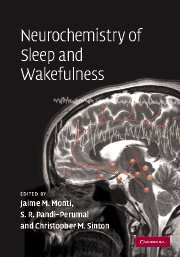Book contents
- Frontmatter
- Contents
- List of contributors
- Preface
- Acknowledgements
- Abbreviations
- I The neurochemistry of the states of sleep and wakefulness
- II The influence of neurotransmitters on sleep and wakefulness
- III Changing perspectives
- 10 Melatonin and its receptors: biological function in circadian sleep–wake regulation
- 11 Sleep regulatory factors
- 12 Adenosine and sleep–wake regulation
- 13 Prostaglandins and the regulation of sleep and wakefulness
- 14 Neuropeptides and sleep–wake regulation
- 15 Orexins in sleep and wakefulness: rodent models of narcolepsy–cataplexy
- 16 The relevance of experimental pharmacology to currently available sleep–wake therapeutics
- Index
- Plate section
11 - Sleep regulatory factors
from III - Changing perspectives
Published online by Cambridge University Press: 23 October 2009
- Frontmatter
- Contents
- List of contributors
- Preface
- Acknowledgements
- Abbreviations
- I The neurochemistry of the states of sleep and wakefulness
- II The influence of neurotransmitters on sleep and wakefulness
- III Changing perspectives
- 10 Melatonin and its receptors: biological function in circadian sleep–wake regulation
- 11 Sleep regulatory factors
- 12 Adenosine and sleep–wake regulation
- 13 Prostaglandins and the regulation of sleep and wakefulness
- 14 Neuropeptides and sleep–wake regulation
- 15 Orexins in sleep and wakefulness: rodent models of narcolepsy–cataplexy
- 16 The relevance of experimental pharmacology to currently available sleep–wake therapeutics
- Index
- Plate section
Summary
Isolation of sleep factors from animals: historical perspectives
The concept of sleep factors stemmed from the commonplace observation that prolonged wakefulness makes people more sleepy. This led to the idea that, during wakefulness, an endogenously occurring sleep-inducing substance may accumulate in the body and this, in turn, would foster sleep. The first experiments addressing this hypothesis were performed independently in Japan by Ishimori (Ishimori 1909) and in France by Legendre and Piéron (Legendre and Piéron 1910, 1912) at the beginning of the twentieth century. In both series of experiments, cerebrospinal fluid (CSF) or serum of sleep-deprived dogs induced increased sleep in recipient animals. This suggested to the French scientists the accumulation of a “hypnotoxin” during wakefulness.
The quest for a key endogenous substance, the action of which is solely or mainly responsible for sleep, continued well into the 1980s. The heroic early era of endocrinology that yielded the discovery of key hormones that regulate various aspects of homeostasis, growth, and reproductive functions, also greatly influenced sleep research. Repeated attempts were made to try to identify and isolate the key hormone that may be responsible for sleep regulation. Schnedorf and Ivy successfully replicated the experiments of Legendre and Piéron 30 years later (Schnedorf and Ivy 1939).
- Type
- Chapter
- Information
- Neurochemistry of Sleep and Wakefulness , pp. 315 - 336Publisher: Cambridge University PressPrint publication year: 2008



